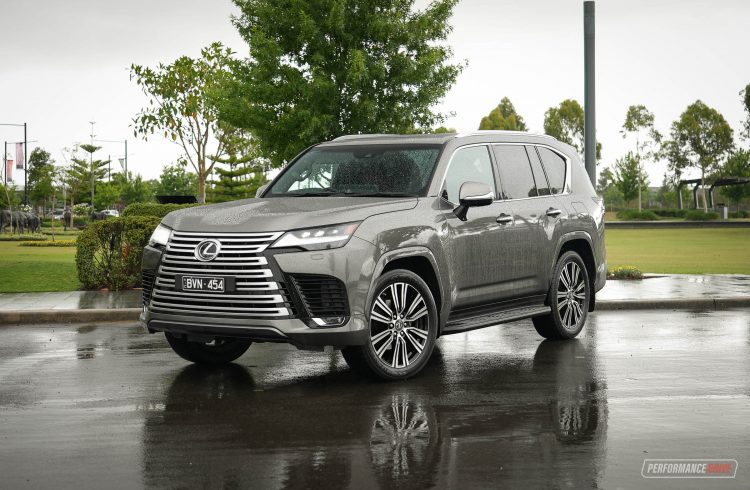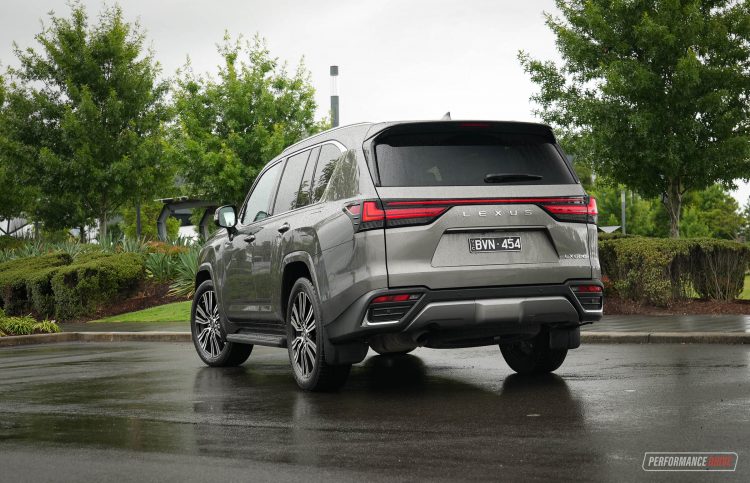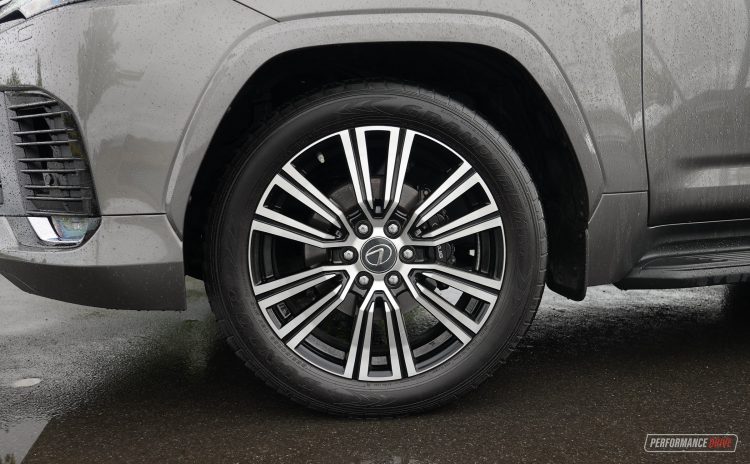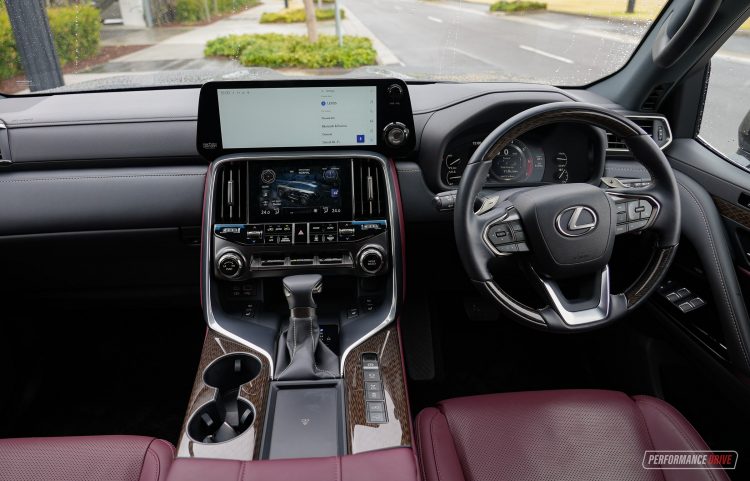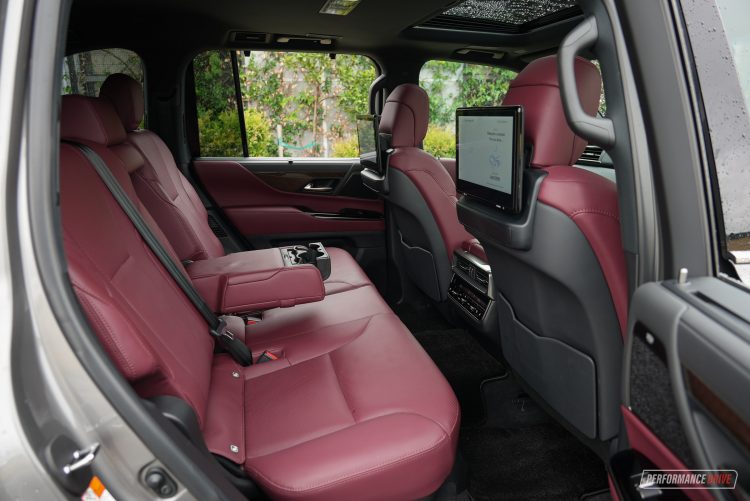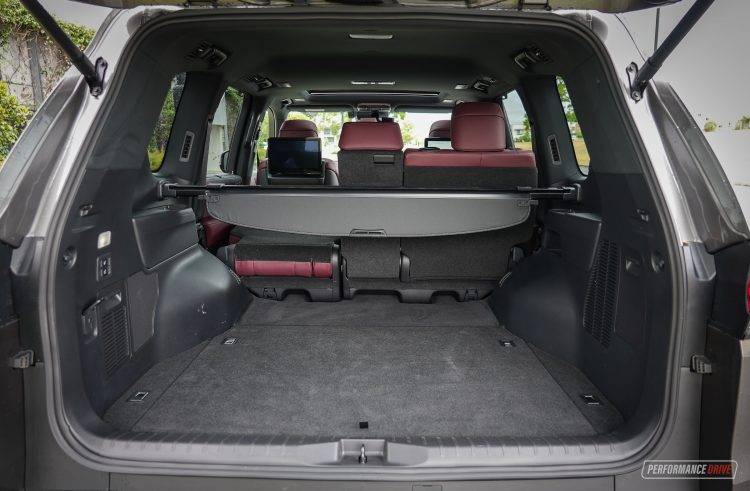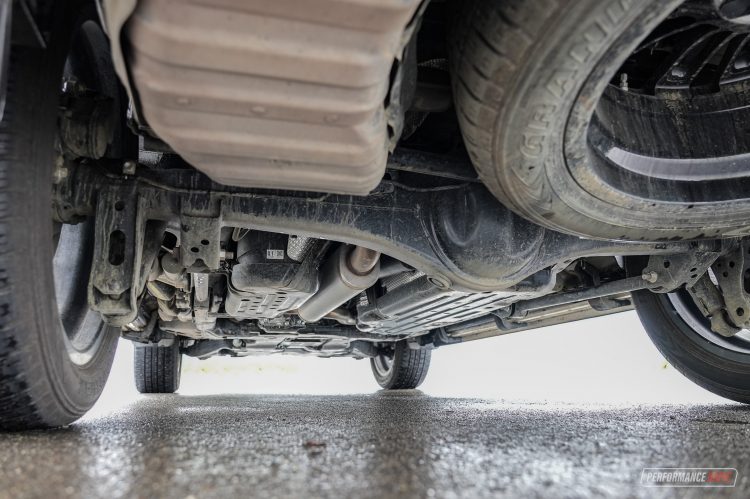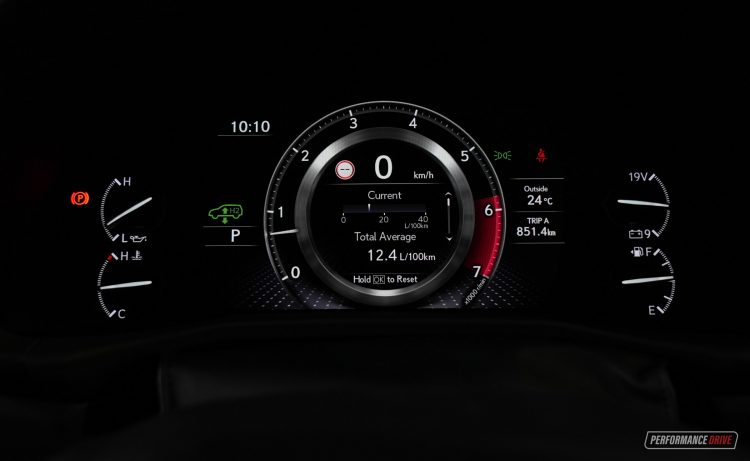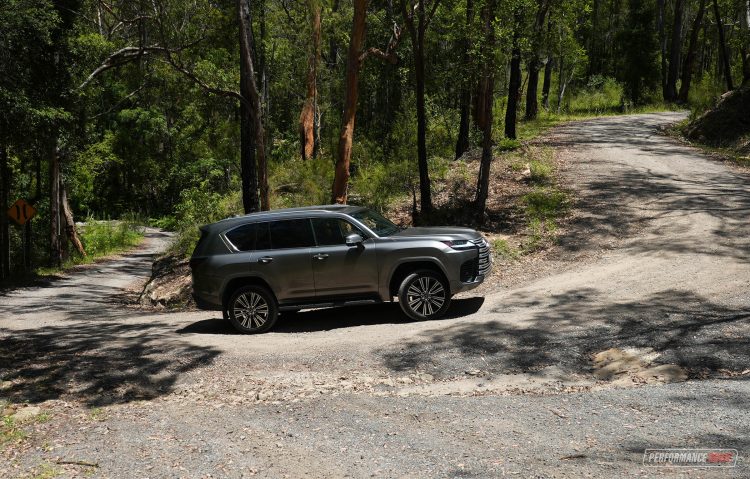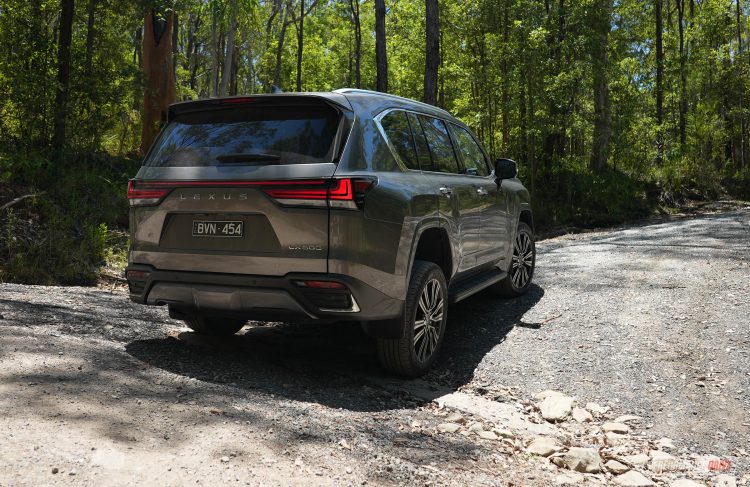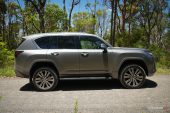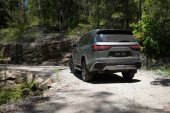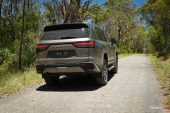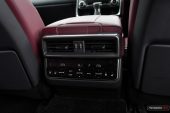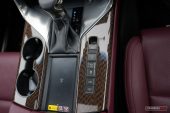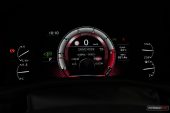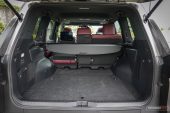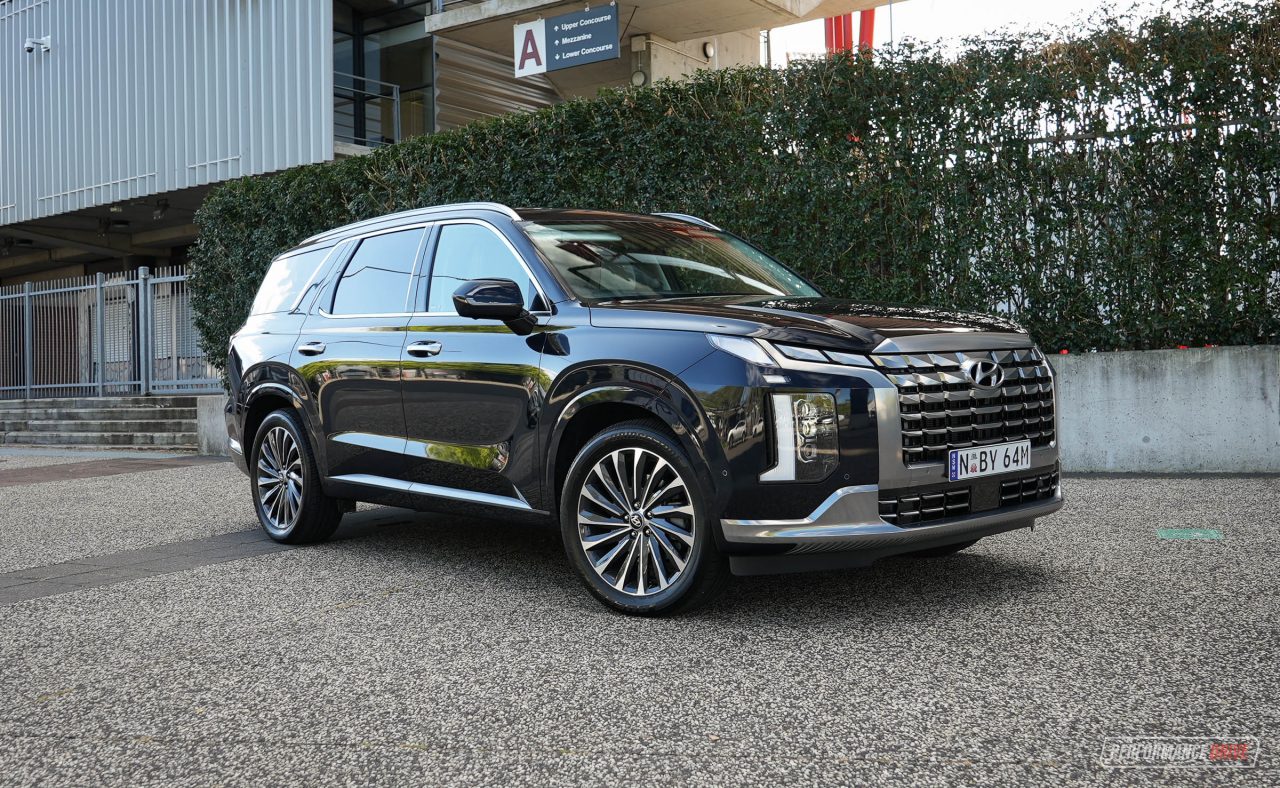The 2023 Lexus LX 600 is the latest iteration of the full-size luxury SUV from Lexus, and it certainly makes an impression. It’s big and bold, and exudes capability, comfort and power.
The mack daddy of all Lexus SUVs is based on the mighty 300 Series Toyota LandCruiser, only it features a Lexus-exclusive (in Australia) 3.4-litre twin-turbo V6 petrol engine option. This replaces the old 5.7-litre V8 petrol. Don’t even begin to second-guess this new V6, though. It offers a lot more power and shiploads more torque than any previous V8. How does 305kW and an earth-twisting 650Nm sound?
The LX 600 sits above the LX 500d diesel, which shares the LandCruiser’s new 3.3-litre twin-turbo diesel V6. You can get both engines in base seven-seat form, or Sports Luxury and F Sport, or, with the LX 600, move up to the Ultra Luxury four-seat trim grade (not available on 500d). Prices start from the following (excluding on-road costs):
2023 Lexus LX 600 Sports Luxury – THE SPECS
[column width=”47%” padding=”6%”]Engine: 3.4-litre twin-turbo V6 petrol
Output: 305kW@5200rpm / 650Nm@2000-3600rpm
Transmission: 10-speed auto
Drive type: Four-wheel drive with dual-range, diff locks
Wheels: F & R: 22×8.0, 265/50
ANCAP: Five stars
Tare weight: 2565kg
Power-to-weight: 8.40:1 (kg:kW)
Official fuel economy: 12.1L/100km
Economy during test: 12.4L/100km[/column] [column width=”47%” padding=”0″]Fuel capacity/Type: 110L/95 RON
Power efficiency: 25.20kW:L/100km
0-60km/h: 3.06 seconds*
0-100km/h: 6.38 seconds*
60-110km/h: 4.26 seconds*
1/4 mile: 14.63 seconds at 158.9km/h*
Max acceleration: 0.700g
100-0km/h braking: 3.41 seconds at 43.34 metres*
Max deceleration: -1.200g
Decibel at idle: 40*
Peak decibel at 60-100km/h: 83*
Priced from: $168,491[/column][end_columns]
* Figures as tested by PerformanceDrive on the day. Factory claims may be different
2023 Lexus LX 600 Sports Luxury – THE PACKAGE
We’re sure you’ll agree, it’s not exactly an handsome-looking machine, is it? However, there are enough Lexus design traits here to let you and everyone know this is a big deal. At the front is a huge ‘spindle’ grille blending with the company’s current design language, cascading right down to the front skid plate section under the bumper bar.
Bolstered yet flattened wheel arches are similar to its LandCruiser cousin, while at the back we think it looks pretty neat and modern. The full-width taillight is perfectly on trend at the moment, and the new Lexus lettering across the tailgate provides an elegant touch. There’s also a pre-cut section in the rear bumper bar for a tow bar installation.
This Sports Luxury variant dons a set of whopping 22-inch alloy wheels, which help provide a maximum running clearance of 308mm when the standard height-adjustable suspension is in its highest setting. We think the spoke design of the wheels is very sophisticated and classy, but we’re not sure how long the prestige look will last off road as the 265/50 tyres are relatively low profile – opt for the 20-inch items if you’re planning serious off-road trips.
Inside, the vast cabin is more like the bridge on a yacht, with a huge centre console dividing the front passengers, and lots and lots of interesting buttons and controls across the dash and console – it’s fun to just sit in here and figure out what all the buttons do. There’s also two touch-screens, with the main 12.3-inch unit at the top showcasing the menu functions and the lower 7.0-inch unit housing the settings for the climate control and core vehicle adjustments such as the ride height.
The main screen isn’t as complete as the rest of the cabin in our opinion, as there appears to be a lot of blank space in many of the menus. It’s also odd there are no graphical themes or colours going on in the background, only a day and night theme to toggle through. Unless we missed something?
Look how much space there is for the wireless phone charger in the middle. It’s insane. There’s even a fridge under the arm rest. Yep, a proper drinks-cooling fridge which you can turn on and off. Helping with touring capability, the front chairs are not your typical car seats. These are large and super-comfortable and supportive. Lexus uses very soft leather and high-qualities materials too, so there is differently a thick ambience of upper-class luxury going on.
Rear passengers are not left without appointments. As you jump in you might notice two 11.6-inch touch-screens, for example. These can play media through WiFi or a HDMI cable. There’s also dual-zone climate control functions and seat heating and ventilation for the outer positions, and a reclining bench seat. Basically, it’s as comfortable back here as it is in the front.
The Sports Luxury is a five-seater only, leaving a monstrous boot at the back. With 1109 litres available in the default layout, and 1960L with the rear seats folded, you’ve almost got the cargo space of a van. There’s so much room, kids can fully stand up in the back. On the boot wall you’ll find an Australian outlet socket (220V), and there’s some extra plastic-moulded storage under the floor for wet or mucky items.
Safety has been taken seriously on this model as it comes fitted with a suite of active safety systems such as adaptive cruise control, lane departure warning, and an excellent surround-view parking camera system. There’s also the new front centre airbag (now a requirement for five-star ANCAP credentials), front and rear autonomous emergency braking, trailer sway control, and auto emergency call assist as part of Lexus Connected Services – this also provides remote vehicle-to-user communication so you can check the vehicle’s status from anywhere and even hone in on its location.
2023 Lexus LX 600 Sports Luxury – THE DRIVE
Even though the whole vehicle is one impressive chunk, this new-ish (debuted in the LS 500 in 2018) twin-turbo V6 is a real gem. With 305kW, it is obviously very powerful. But the more important figure is 650Nm. That’s big torque for a petrol engine, and it means there is absolutely no struggle getting up to speed. Unlike previous V8 petrol models, this V6 doesn’t need to rev hard to prove its worth either. You only need to lean on the throttle to charge your way off at the lights.
Instead of trying to explain the acceleration potential, let’s just go over our real-world acceleration test results, fed from our Vbox Sport GPS data-logger. We clocked 0-100km/h in just 6.38 seconds. That’s properly quick for a massive SUV like this. Especially one that uses live axle rear suspension and a heavy ladder-type chassis. Our result was achieved by first building some revs on the brake pedal. If you just stomp on the throttle expect to hit Lexus’s official claim of 7.0 seconds, as we scored 7.02 seconds.
The engine doesn’t run out of puff as the speed climbs. It continues to steam forward like a train rolling downhill. In fact, the top end thrust is a lot more exhilarating than you might expect. The engine seems to reserve turbo boost and unleash a continuous torrent of force beyond around 60km/h. This is a heavy vehicle, as you probably assumed, weighing in at 2565kg (tare). So it’s understandable it would require a lot of energy to get things moving off the line. However, as the 0-100km/h time shows, it leaps and just keeps galloping.
You can hear there is a nice sound in there too, although, we’d love to hear it with a bi-modal or aftermarket exhaust system. Obviously a loud exhaust is not what the LX is all about and we don’t mean to criticise it for being too quiet. We’re simply saying it would be interesting to see this beauty with some of its clothes off, figuratively speaking.
Surprisingly, fuel economy is pretty good as well, especially for such a large and heavy vehicle with this much power. The official average is 12.1L/100km, which is rather high for a modern car. But again, keep in mind this is not a regular hatchback. Better yet, we achieved 12.4L/100km after a week of testing (covering 851km). And that included performance testing and a good mix of highway driving and poking around in town.
Underneath it all is the heavy-duty TNGA-F platform, consisting of a full ladder-type chassis and live axle rear suspension, as mentioned. All versions come standard with height-adjustable suspension as well as adaptive variable dampers (or Active Variable Suspension in Lexus speak) with various driving modes. We think the ride is a bit choppy and bouncy, likely due to the suspension working hard to contain this big barge.
Over shorter undulations and corrugations it tips and rocks forward and back slightly. It never feels unsettled or disruptive to your progress, however, we think a comprehensive air suspension setup might have been a better option here; this uses coil springs. On the contrary, off-road comfort is admirable. Although the suspension might be a tad firm on the road, it has no trouble taking on and absorbing bigger impacts off the road. Which makes sense as this is not an SUV, but a fully-fledged off-road vehicle.
Power is distributed to a full-time four-wheel drive system and drivers have a low-range transfer case to engage. A lockable Torsen centre differential and a locking rear differential means there ain’t many surfaces that will stop this machine. Raise the ride height right up and flick it into low-range and, man, it’s unstoppable. Again though the tyres and those big wheels are the weakest link. But it’s hardly a weak link in the first place.
2023 Lexus LX 600 Sports Luxury – THE VIDEO
2023 Lexus LX 600 Sports Luxury – THE VERDICT
If top range quality blended with sheer practicality and unyielding reliability are among your primary requirements for a new large SUV, the Lexus LX is an incredible beast. It has the running gear of perhaps the most famously-capable mass-produced vehicle the world has ever known, layered with high-end luxury and quality, backed by Lexus’s repeatedly-awarded customer service and praised long-term ownership experience. Need we say more? If you’re thinking of driving around Australia, or simply like the idea of driving something that can easily do it, this is your machine.
Our recommendation is to go for either the petrol or diesel engine. Yep. It only comes in these two forms but we think both of them are positively fit-for-purpose. If fuel economy and long-distance touring is higher on your priority list, then the 500d diesel might suit you best. But then again, this petrol unit is surprisingly fuel efficient.
Going back the other way and the diesel is only 1 second behind this 600 across 0-100km/h (according to our results), so the diesel is no slow coach either. It is a tough decision. In the end we would probably go for this petrol simply because it is supremely smooth and it sounds more refined, perhaps better fitting with Lexus’s heritage.
[column width=”47%” padding=”6%”]PROS:
– Twin-turbo V6 offers all the majestic power and relentless torque you could ever need
– Massive cabin, and it’s filled with practicality, luxury and convenience
– Real-world fuel economy (for its class)
– Lots of clever tech and gadgets to play with
– Real off-road performer
[/column] [column width=”47%” padding=”0″]CONS:
– Looks like a giant boulder?
– Suspension can be choppy on some surfaces
– Too much blank space in the main touch-screen[/column][end_columns]
As always, if you’re thinking about buying a new car don’t forget to click here to speak with our car buying specialists.
